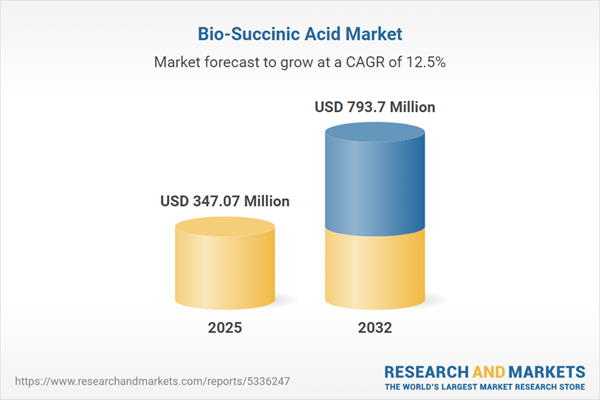Speak directly to the analyst to clarify any post sales queries you may have.
The bio-succinic acid market presents a pivotal opportunity for senior leaders focused on driving sustainable growth and building operational resilience. With renewable sourcing and circular economy initiatives becoming integral to global procurement strategies, this sector enables organizations to pursue compliance, innovation, and eco-friendly chemical alternatives across key industries.
Market Snapshot: Bio-Succinic Acid Market Overview
Current research underscores sustained expansion in the bio-succinic acid market, positioning it as essential for organizations navigating the transition to renewable chemicals. Enterprises in packaging, automotive, construction, and consumer goods are at the forefront, adopting bio-succinic acid to support green manufacturing and advance circular economy frameworks. Ongoing regulatory pressures regarding emissions and transparency add impetus, compelling senior decision-makers to refine procurement and supply chain structures to enhance competitiveness and maintain readiness in evolving global contexts.
Scope & Segmentation of the Bio-Succinic Acid Market
This report provides a strategic, executive-focused overview of the bio-succinic acid market. Key segmentation and scope considerations are as follows:
- Product Forms: Crystalline, powder, and solution variants are covered to ensure compatibility across manufacturing lines and adherence to compliance protocols.
- Production Methods: Catalytic hydrogenation, butadiene oxidation, and microbial fermentation are detailed, offering diverse technological options for scalable and sustainability-aligned production.
- Applications: Usage areas include food additives, personal care products, pharmaceuticals, plasticizers for PVC and rubber, polyester polyols for resins and polyurethanes, and solvents applicable to coatings, inks, and cleaning agents.
- End Use Industries: Sectors such as agriculture, automotive (covering both OEM and aftermarket), construction, pharmaceuticals, packaging, and consumer packaged goods are profiled, reflecting varied demand patterns and procurement requirements.
- Sales Channels: Direct sales and distributor models are examined, facilitating adaptable go-to-market strategies and flexible client relationships.
- Regional Coverage: Analysis spans the Americas, Europe, Middle East, Africa, and Asia-Pacific, with particular attention to China, India, Germany, Brazil, and the United States, highlighting region-specific regulatory, supply, and expansion dynamics.
- Key Companies: The competitive landscape assesses Ensince Industry Co., Ltd.; Reverdia B.V.; Haihang Industry Co., Ltd.; Fengchen Group Co., Ltd.; TRIGON Chemie GmbH; BASF SE; Vigon International LLC; Spectrum Chemical Mfg. Corp.; Roquette Frères; and DSM-Firmenich AG, guiding supplier assessment and selection.
Key Takeaways for Senior Decision-Makers
- Building strong supplier networks and adopting agile procurement models enables organizations to respond rapidly to shifting regulations and strengthen supply chain reliability.
- Advancements in fermentation and catalytic processing broaden material options, creating new application possibilities and reinforcing organizational relevance in the evolving bio-based chemicals landscape.
- Strategic alliances between biotechnology and chemical manufacturers are driving co-development of advanced polymers, adhesives, and specialty applications, expanding market scope and enabling tailored solutions.
- Regional diversity in regulatory frameworks and supply logistics requires customized sourcing and distribution plans to maintain flexibility and mitigate risks.
- Diversification of procurement channels and supply lines equips enterprises to proactively manage pricing impacts and respond effectively to unexpected market interruptions or disruptions.
Tariff Impact: Strategic Implications of U.S. Trade Changes
Recent shifts in U.S. tariffs on imported succinic acid derivatives are prompting organizations to recalibrate sourcing approaches. There is growing emphasis on leveraging domestic and regional supplier networks for reliable access and cost control. To respond effectively to legislative changes, companies are embedding technology-enabled partnerships and sophisticated resource planning, reinforcing operational agility while maintaining uninterrupted market presence through dynamic trade conditions.
Methodology & Data Sources
Insights are drawn from direct executive interviews, in-depth market literature reviews, and ongoing monitoring of regulatory and intellectual property developments. Data modeling across market scenarios anchors findings in board-level strategic imperatives, providing robust, scenario-based recommendations for executive teams.
Why This Report Matters
- Assists senior leadership in adapting to evolving global regulations and accelerating innovation while embedding compliance into operations.
- Supports the creation of agile procurement strategies and resilient supply chains capable of adjusting to shifting market and regulatory landscapes.
- Provides actionable, targeted intelligence allowing organizations to sustain competitiveness and establish structured, long-term growth pathways across different regions and industry environments.
Conclusion
Targeted investment in bio-succinic acid advances sustainability goals and readies organizations for regulatory transformation. Proactive strategy in sourcing and operations will underpin future competitiveness and long-term resilience.
Additional Product Information:
- Purchase of this report includes 1 year online access with quarterly updates.
- This report can be updated on request. Please contact our Customer Experience team using the Ask a Question widget on our website.
Table of Contents
3. Executive Summary
4. Market Overview
7. Cumulative Impact of Artificial Intelligence 2025
List of Figures
Companies Mentioned
The companies profiled in this Bio-Succinic Acid market report include:- Ensince Industry Co., Ltd.
- Reverdia B.V.
- Haihang Industry Co.,Ltd.
- Fengchen Group Co.,Ltd
- TRIGON Chemie GmbH
- BASF SE
- Vigon International, LLC.
- Spectrum Chemical Mfg. Corp.
- Roquette Frères
- DSM-Firmenich AG
Table Information
| Report Attribute | Details |
|---|---|
| No. of Pages | 196 |
| Published | November 2025 |
| Forecast Period | 2025 - 2032 |
| Estimated Market Value ( USD | $ 347.07 Million |
| Forecasted Market Value ( USD | $ 793.7 Million |
| Compound Annual Growth Rate | 12.5% |
| Regions Covered | Global |
| No. of Companies Mentioned | 11 |









